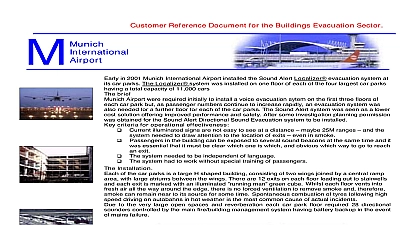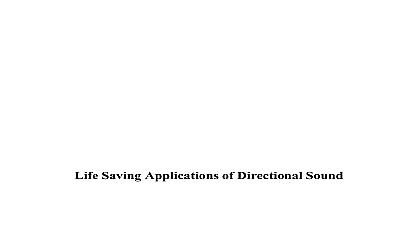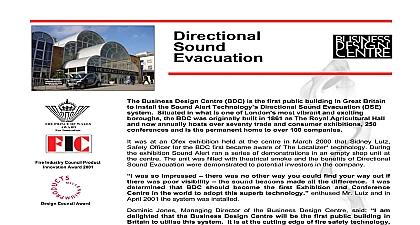System Sensor Directional Sound Evacuation

File Preview
Click below to download for free
Click below to download for free
File Data
| Name | system-sensor-directional-sound-evacuation-6503841279.pdf |
|---|---|
| Type | |
| Size | 627.95 KB |
| Downloads |
Text Preview
Sound Evacuation an improved system for way guidance Professor Deborah Withington School of Biomedical Sciences Worsley Medical and Dental Building of Leeds Leeds LS2 9NQ U K and Mike Lunch Sound Alert Technology plc Old Village Hall The Effingham Surrey KT24 5JS UK on survivors of evacuation incidents has shown that finding the nearest available exit is the important determinant of survival It is therefore essential that individuals be guided to available routes in the least possible time To achieve this and ensure balanced exit usage individuals must to identify and find their optimal exits using the most effective sensory information that vision is the primary sense it is understandable that the majority of emergency exit aids as lighting signage and photo luminescent guidance strips are all visual aids However the given by visual aids may be reduced or rendered totally ineffective in a smoke filled Considerations studies have repeatedly shown that the most natural instinct in the event of an evacuation to leave by the same route used for entry since this route is known Frequently these exits are the quickest nor the most appropriate People fail to notice nearby exits and in some cases straight past visible fire exits During evacuation the circulation routes used for normal everyday may encounter higher population flows than they were designed for This results in and a slowing down of the evacuation process visual clutter of information and advertising signage may seriously impair identification of an exit route even in normal visibility In some instances the nearest exit may not be visible and present there is nothing to draw attention to it process of evacuating a large passenger ship is a complex one not least because it involves the of a high population density on a moving platform The design and layout of ships often narrow confined corridors and very few external reference points can create difficulties in orientation since most will be unfamiliar with the environment evacuating a ship while at sea vessel motion is a factor that affects both mobility and way abilities When subjected to motion the brain is occupied with maintaining balance while hence the ability to process information and make judgement is impaired consequently way abilities decrease Motion sickness and nausea are results of visual vestibular mismatch of movement with no visual evidence which reduces mental awareness Sound localisation primarily a subconscious task and as such does not add to the burden of visual vestibular In view of this the use of directional sound may be more suitable as a guidance aid onboard from the UK Building Research Establishment show that well illuminated visual signage is at a distance greater than 1.5m in dense smoke There are many examples of evacuations smoke in which the inability to find exits has resulted in multiple fatalities April 1990 a fire onboard the ferry SCANDINAVIAN STAR killed 158 passengers Many deaths in passageways close to emergency exits and in cabins Many survivors claimed that it was to see the emergency exits in the smoke filled corridors The Norwegian Fire Research performed a series of evacuation trials on a reconstructed section of the SCANDINAVIAN using the original emergency signage It was found that 40 of test subjects failed to find the exit They either passed it or tried to exit through the wrong door In their summary the researchers stated do know that emergency lighting and marking signs do not help to people among the evacuation routes available Official Report NOR 1991 1E on the SCANDINAVIAN STAR Disaster stated recommends that a requirement be introduced that audible signals with a sound that clearly them from the alarm bells be installed by the exit doors in escape routes on board ships as directions for escape in conditions of reduced visibility Technology is used in emergency evacuations to provide an which merely alerts people to an danger Irrespective of whether this information is provided by conventional alarm tones or voice messaging these give no information concerning the direction to or location of the exits These alarms are positioned to alert as wide an area as possible but even if they were over exit doors they would still be very difficult to locate quickly To understand why these would not suffice as exit locators it is necessary to describe how we locate sounds in space an accuracy of 2 4 degrees accurate localisation the brain has to decode three types of sound cues which individually convey limited amounts of spatially ambiguous information The first two are known as binaural cues as make use of the fact that we have two ears separated by the width of our head A sound that from either side of the midline of the head will arrive first at the ear closest to it and will also louder It is this difference in path length that forms the basis for binaural processing there are further complications with binaural cues Firstly the brain is very sensitive to phase of an incoming waveform at frequencies below 1 kHz so interaural time differences the difference between each ear ITDs are only really applicable at frequencies below this threshold addition for the loudness differences or interaural intensity differences IIDs to work the source emit a sound that has frequency components with wavelengths smaller than the diameter of the about 3 kHz and above The use of these two types of cue is known as the theory and proposed by Lord Rayleigh as long ago as 1906 are further problems however as the ITD and IID are virtually identical for sounds emanating directly in front of or behind the head To solve this ambiguity the auditory system uses a third of cue the spectral cue for localisation These spectral cues are provided by the way in which external ear or pinna modifies the spectrum of the received sound such that some frequencies attenuated whilst others are amplified provide complete localisation knowledge information from all three cues must be combined For a to be accurately located it must contain as much of the audible frequency range as possible Hz This is sound and can most easily be described as the sound of a rushing or waterfall Neither conventional alarms nor speech which are narrowband frequencies will as directional sound aids of development of the technology principles of localization of sound have been understood by scientists for many years however concept of using an sound pattern optimised for localization specifically to identify direction was when Professor Withington proposed this as part of her research at Leeds University in This innovative idea technology was patented and a spin off company formed to refine the into practical and commercially viable applications The first directional sound evacuation took place in 1997 in a TV studio at Leeds University where a thermal imaging camera volunteers trying to find their way out of a dark room Using DSE a volunteer got out in just 15 walking directly to the exit as compared to up to 1 minute and 50 seconds feeling around the long succession of development trials and tests lead to the system being used in buildings such as International Airport as well as now being examined by the aircraft industry as a means to aircraft evacuation Sound Alert Technology has funded the development of this technology its own resources encouraged by the enthusiasm and support of the Maritime Coastguard MCA and Maritime Industry in the UK It is now being proposed by UK and Germany to IMO for equivalence to LLL meanwhile several shipyards and owners are keen to the technology to improve life safety with early installations trials series of marine trials were devised by Strathclyde University and the MCA and performed onboard CalMac ro ro vessels in June and October 2001 volunteers for the trials were recruited from the local population and represented ages from 17 both genders Each trial endeavoured to obtain an evenly distributed age range and some included hearing and visually impaired subjects safety reasons smoke used in the trials was theatrical rather than real smoke Theatrical smoke the visual disability associated with real smoke but not the toxic effects The gases in real cause a reflex closing and watering of the eyes consequently vision is almost immediately


